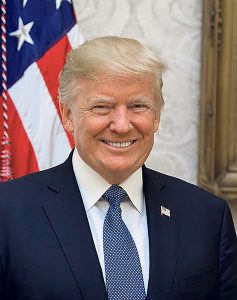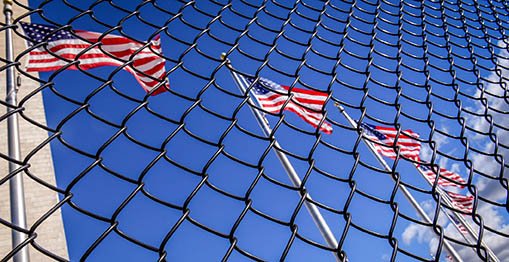The Trump administration lost valuable time preparing for the Covid-19 crisis. Now it cannot afford any missteps when reopening the country. Bette Browne reports
The US’s response to Covid-19 was flawed from the beginning because President Donald Trump viewed it through the lens of his political ambitions, perceiving it as imperilling his chances of re-election rather than as a catastrophic threat to American lives.
When the country needed informed medical advice, it got a Republican President who lashed out at opposition Democrats, blaming them for what he called the coronavirus “hoax” to damage a booming economy on which he had predicated his re-election.
Clearly, it would be wrong to blame President Trump for this deadly global pandemic. But in politics, it is how a leader responds to a crisis that matters most. Practical support is vital, in the form of economic assistance, but most of all people need empathy and a sense of confidence in the veracity of their leader’s pronouncements.

What Americans desperately needed, like other affected countries, was a leader who would move swiftly to tackle the Covid-19 crisis, test widely and relentlessly, and rely first and foremost on expert advice from scientists and medical professionals.
But an examination of the record shows that when the test came for President Trump, and the spotlight fell, it laid bare not only his character flaws but also how his administration’s policies had left the nation’s healthcare agencies underfunded and understaffed and thousands of Americans without health insurance.
Even while the pandemic was surging across the country in April, the Trump administration decided to close access for new customers to apply for health insurance under the government’s Affordable Care Act (ACA). In the past during natural disasters, the government extended the period for applying for such insurance under the decade-old ACA. A month before that, Trump said his administration would continue to support a lawsuit which, if successful, will essentially kill the ACA.
Early stages
But the flawed response was most evident in February in the early stages of the crisis, when valuable time was lost. When he should have been preparing the country for the reality of the crisis, the President was lashing-out at those whom he perceived as “exaggerating” the seriousness of the situation. Indeed, in retrospect, February will be seen as the month of America’s lost opportunity to impede the deadly march of the pandemic.
It wasn’t as if there had been no warnings about the seriousness of the outbreak. US intelligence agencies had issued warnings about the novel coronavirus in more than a dozen classified briefings for the President in January and February.
In a warning on 29 January, seen by the New York Times, Mr Peter Navarro, President Trump’s trade adviser, said: “The lack of immune protection or an existing cure or vaccine would leave Americans defenceless in the case of a full-blown coronavirus outbreak on US soil. This lack of protection elevates the risk of the coronavirus evolving into a full-blown pandemic, imperilling the lives of millions of Americans.” Mr Navarro delivered a similar warning again on 23 February.

In his State of the Union speech before Congress on 4 February, President Trump said he was working with Beijing “on the coronavirus outbreak in China” but did not mention that US intelligence agencies had already sent a number of warnings to the White House.
On 10 February, he was still dismissing the enormity of the crisis, declaring at a New Hampshire rally for his re-election: “Looks like by April, you know, in theory, when it gets a little warmer, it miraculously goes away.”
Even as late as 24 February, he was still assuring Americans all would be well, tweeting: “The coronavirus is very much under control in the USA. Stock market starting to look very good to me!”
As moves finally began to shut down much of the country and enforce social distancing, the President told a news conference on 27 February: “It’s going to disappear. One day, it’s like a miracle, it will disappear.”
Meanwhile, he was still continuing to hold campaign rallies and blaming Democrats for the crisis. At a 28 February rally in South Carolina, for example, he called the deadly virus a “new hoax” by Democrats to undermine him. It was exaggerated, he declared, calling it a “foreign virus”.
Earlier he told Fox News he had “shut it down”. He also dismissed the severity of the outbreak, comparing it to the seasonal flu.
Thus, valuable time to prepare for the crisis was lost and hospitals ran low on personal protective equipment, ventilators and respirators. State and local governments, particularly New York, were left scrambling on their own to build capacity so that patients would not be denied care.
The response also exposed the inadequate state of the public health system. Tests were delayed, for example, by contamination at a lab at the Centres for Disease Control and Prevention (CDC), while a persistent lag in building testing capacity meant local officials were in the dark about the size of their outbreaks.
With limited exceptions — namely Dr Anthony Fauci, Director of the National Institute of Allergy and Infectious Diseases, and Dr Deborah Birx, who had led the government’s fight against the global AIDS epidemic — the President failed to surround himself with medical and scientific advisers who could assist him in laying out the facts about the virus and its deadly consequences.
As February turned to March, the first deaths were announced. Soon the numbers were climbing. President Trump began to acknowledge the spread of the virus within the US, but dismissed the potential danger to the public at large.
On 9 March, when 22 deaths were reported, he declared: “The fake news media and their partner, the Democrat Party, is doing everything within its semi-considerable power… to inflame the coronavirus situation.”
One day later, he told Republican senators: “We’re prepared, and we’re doing a great job with it. And it will go away. Just stay calm. It will go away.” Later that month, he said: “This is a very contagious virus. It’s incredible. But it’s something that we have tremendous control over.”
National emergency
His approach began to change on 13 March when he finally declared a national emergency, which freed-up billions in funding for states to fight the virus. On 16 March, he appeared at a White House news conference in sombre mood as the US death toll climbed relentlessly and impacted all 50 states.
He seemed to have finally grasped the enormity of the crisis. By 17 March, his Treasury Secretary was working with Congress to pass an economic package of almost two trillion dollars to help American businesses and individuals to fight the disease.
This has since been expanded. On 22 April, the Senate passed a $484 billion (€446 billion) coronavirus relief package, which included $75 billion (€69 billion) for hospitals and $25 (€23 billion) billion for testing.
But hopes were soon dashed that the President would demonstrate the kind of the leadership so desperately needed by the states in the grip of the virus. Instead, he reverted to using his daily White House briefings to attack governors and others who criticised his response to their calls for more protective equipment and testing.
When Americans desperately needed to stay at home and implement social distancing, he began to undermine such measures. “America will again, and soon, be open for business — very soon — a lot sooner than three or four months that somebody was suggesting. We cannot let the cure be worse than the problem itself.” On 24 March, he declared he wanted the country opened up by Easter Sunday.
However, briefed in detail by Dr Fauci and Dr Birx on what lay ahead, he began to grasp the awful reality that America was facing what would be its worst nightmare in 100 years. Both doctors warned that between 100,000 and 200,000 Americans could die and that millions would be infected.
On 6 April, however, he turned his ire on the World Health Organisation (WHO), threatening its funding and charging that it got “every aspect” of the pandemic wrong. He ignored the fact that the WHO had declared the pandemic a global emergency on 30 January, which was six weeks before he himself declared a national emergency in the US.
Funding cuts
The US response to the crisis was also exacerbated by threats of cuts to funding and personnel in the health agencies and their vital programmes. The administration repeatedly proposed significant cuts to health and science agencies, including the 2021 budget, in which President Trump called for an almost 10 per cent reduction in health and human services funding overall and a nearly 16 per cent slash at the CDC. While Congress ignored those proposed cuts and instead increased funding to the CDC and National Institutes of Health, some initiatives aimed at battling epidemics have since been cut or eliminated.
In 2018, when the White House declined to provide the CDC with additional resources, the agency downsized by 80 per cent programmes designed to prevent the spread of infectious diseases. The administration also shuttered the National Security Council’s global health security unit, which had been set up by President Barack Obama, to respond to global health emergencies.
The President has made personnel and budget decisions that have reduced the ranks of senior public health officials in the upper echelons of the administration, lessening the federal government’s capacity to respond to public health emergencies.
An analysis by the bipartisan National Task Force on Democracy Reform and the Rule of Law at the Brennan Centre for Justice has detailed the growing politicisation of US government science. It proposed reforms that would help ensure that the government can respond to public health crises. Such reforms, it said, would “curb political interference in government science and fix a broken appointments process”.
Americans tell pollsters they are dismayed at President Trump’s handling of the pandemic. In a poll by NBC-Wall Street Journal at the end of April, 65 per cent said he did not take the coronavirus seriously enough when it first presented. Some 52 per cent disapproved of his response to the global outbreak, while 44 percent approved. By contrast, a majority said they trusted the CDC and Dr Fauci.
Of course, the US wasn’t the only country to falter in response to the pandemic. The WHO has pointed out that up to half of coronavirus-related deaths in Europe have occurred in long-term-care facilities such as nursing homes, an assessment that suggests there was insufficient awareness or action by public health authorities when the epidemic struck.
Reopening
But whatever about President Trump’s early missteps in responding to the pandemic, he cannot afford to mishandle the phased reopening of America.
The biggest test for the President and the US, as with most of the rest of the world, lies ahead — how to safely move from lockdown to a reopening of countries and their economies. If Covid-19 bounces back, it could be worse than when it first struck.
This also could make it even more difficult to re-impose restrictions on people, goods and businesses. Healthcare capacity for testing and contact-tracing must first be fully up-to-speed, as well as the ability to shield at-risk groups.
To date, matters haven’t started well for America, with divisions surfacing in some states over whether and how soon to start the re-opening phase. Indeed, President Trump has seemed to only encourage such divisions and to take his lead from Republican governors rather than health officials.
In a series of controversial tweets in recent weeks, he called on people to “liberate” three states — Michigan, Minnesota and Virginia — where protesters had called for a loosening of social distancing restrictions. He also said at a White House briefing that “some governors have gone too far” in their restrictions.
It was left to Dr Fauci to warn that if states “jump the gun” on reopening, “you’re going to set yourself back.”
But Dr Fauci’s caution appeared to have little impact on the President, who tweeted on 30 April that he plans to resume holding political rallies and will not be enforcing social distancing rules for his events.
“Hopefully in the not-too-distant future we’ll have some massive rallies and people will be sitting next to each other.
“I can’t imagine a rally where you would have every fourth seat full, every six seats are empty for everyone. That wouldn’t look too good.”
While ramping-up testing will be key in moving to a re-opening, President Trump has already said that a critical component of tests, the reagent, is “so easy to get”, though governors from both parties and public health officials say it is not.
“There will be no way to ramp-up and get the number of tests, and the auxiliary things like the swabs that we need unless the federal government takes over,” New York Senator Chuck Schumer said. “Other countries are way ahead of us. Mr President, you’re hurting the recovery you want so badly, by not having the tests. The best way to recover quickly is testing, testing, testing.”
An analysis by health researchers at Harvard University found that more than half of US states still lack the testing capacity necessary to bring the virus under control.
Seven coronavirus models show US deaths will continue to rise, but how sharply depends on how much “contact reduction” Americans practice, the CDC said in a report at the end of April.
Dr Fauci has warned that a second round of coronavirus infection is “inevitable” and its severity would depend on the progress the US makes in the coming months. “If by that time we have put into place all of the counter-measures that you need to address this, we should do reasonably well,” Dr Fauci said. “If we don’t do that successfully, we could be in for a bad fall and a bad winter.”
He emphasised the federal government needs to provide strategic guidance and assistance to help states up their number of conducted tests and he hopes those who need a test can get one by early June.
Being able to test for the virus, track cases and isolate every infected American will be key factors in ensuring that second wave isn’t as deadly, Dr Fauci said. However, the US continues to lag behind in testing, according to a report in April by the Organisation for Economic Co-operation and Development.
Harvard health researchers have also warned that if America wants the country to reopen and stay open, testing must go up to at least 500,000 people per day.
The number of positive tests must also be much lower, the researchers said. In the US, 20 per cent of those tested for coronavirus get positive results. The WHO has said that to reopen that number should be between 3-to-12 per cent.
Unproven treatments
Most people shrugged-off the President’s bizarre suggestion at a White House briefing on 23 April that bringing “light” inside the body and injecting people’s lungs with “disinfectant” could treat the virus and should be examined. However, he must be aware that millions of vulnerable people are listening to his words and looking to him for advice as they try to find ways to cope with this catastrophe.
In March, after the President had continually touted chloroquine phosphate as a treatment for the virus, a man in Phoenix, Arizona, ingested it and died. “Trump kept saying it was basically pretty much a cure,” the man’s wife told NBC after the tragedy.
The patience and dedication of healthcare professionals pays off in any health crisis, but especially in this one. Despite its missteps in handling this crisis, the Trump administration is beginning to see hopeful signs in the battle.
Dr Fauci recently commented that the experimental drug remdesivir showed promising results in a clinical trial conducted at Massachusetts General Hospital and 50 other sites around the US.
There are multiple projects globally aimed at finding a vaccine, and the Trump administration has launched an operation to marshal US resources to focus on assisting in this mission.
That is what is expected of the world’s most powerful nation when a health catastrophe strikes.













Leave a Reply
You must be logged in to post a comment.